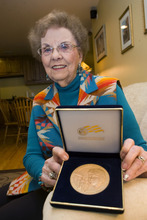This is an archived article that was published on sltrib.com in 2011, and information in the article may be outdated. It is provided only for personal research purposes and may not be reprinted.
Within months after the Japanese attack on Pearl Harbor on Dec. 7, 1941, the U.S. Army Air Force, faced with an acute shortage of male pilots, decided to use women in domestic aviation to relieve their male counterparts for combat.
This was a first for the military. They knew little about women's adaptability, attitudes, strength or psychological bearings. So they turned to world-renowned pilot Jacqueline Cochran, who created in-country ferrying and training programs including aerial navigation, target towing, assimilated bombing missions and conveyance.
Cochran had broken international speed and altitude records. President of the Ninety-Nines, an international organization of women pilots, she was a member of the Wings for Britain, delivered military aircraft from America to England and became the first woman to pilot a bomber across the North Atlantic.
Actively recruited, 25,000 young women stepped forward to volunteer, and about 1,800 were accepted into the program. Learning to fly "the Army way," 1,074 graduated into the Women Air Force Service Pilots, or WASPS. Nell Stevenson Bright, who trained at the Sweetwater, Texas, military flight school, was one of them.
"We grew up in West Texas during the Depression years and were taught to contribute," Bright, 89, said from her Salt Lake City home. "We were also told we could do anything if we worked hard enough. And I'd always wanted to fly."
She had graduated from college at 19, composed newspaper ads in Amarillo and "bummed rides to the airport every morning to get flight training." When she received her pilot's license and built up her hours, Bright enlisted in the Army Air Force (AAF) as a civilian pilot and earned her wings.
"We were paid $250 a month, had to buy our own uniforms, and though we were under military orders and considered officers, technically we were civil service," Bright said. "If one of us died — and 38 women pilots did — the government wouldn't compensate the families to send the body home."
Parents couldn't display in their windows the traditional gold star symbolizing the death of a child in the line of duty. Nor did women pilots receive veteran status.
At the time, though, most thought only about flying.
"It wasn't glamorous work," Bright said, "but getting off the ground and into the air was a wonderful feeling."
Bright received primary and advanced flight training "just like the men," and learned to fly B-25 twin-engine bombers, P-47 pursuit planes, a couple of Navy bombers and 15 other types of aircraft.
Those in the ferry command transported planes from manufacturer to base and one coast to the other, making deliveries as far away as Alaska, where Russian pilots would take them overseas.
At Biggs Field, Texas, Bright flew simulated bombing, gas and strafe missions. She towed target sleeves behind the B-25 for anti-aircraft boys to shoot at before going overseas.
"It was dangerous," she explained. "They were shooting live bullets. Sometimes they'd miss the target and hit the plane."
While in transition school at Mather Field, Calif., Bright and 20 B-25 women pilots faced inequity with the same aplomb with which they took to the air. "The commanding officer didn't particularly want us eating in the officers' mess, but we were officers, so we did."
This attitude held sway when 20 Tuskegee Airmen — the first black fliers in the armed services — arrived on base and were racially segregated. "These trained pilots and officers of the U.S. Army Air Force could not eat with us in the officers' mess," said Bright. "We spoke up. When they were finally allowed in, they had to sit away from everyone else. That was pretty bad, so we joined them."
When Bright's older brother, a crew chief on a B-25 in North Africa, returned to the states for R&R, his sister — first pilot on a B-25 — offered to fly him home. "He couldn't imagine it and wanted to take a bus."
But he didn't dare.
Eileen Hallet Stone, an oral historian, may be reached at ehswriter@aol.com.
Notes: In 1977, the WASPS received veterans' status. In 2010, they were awarded the Congressional Gold Medal by President Barack Obama. Additional sources: Women Pilots of World War II, and aviator Mavis Green.



